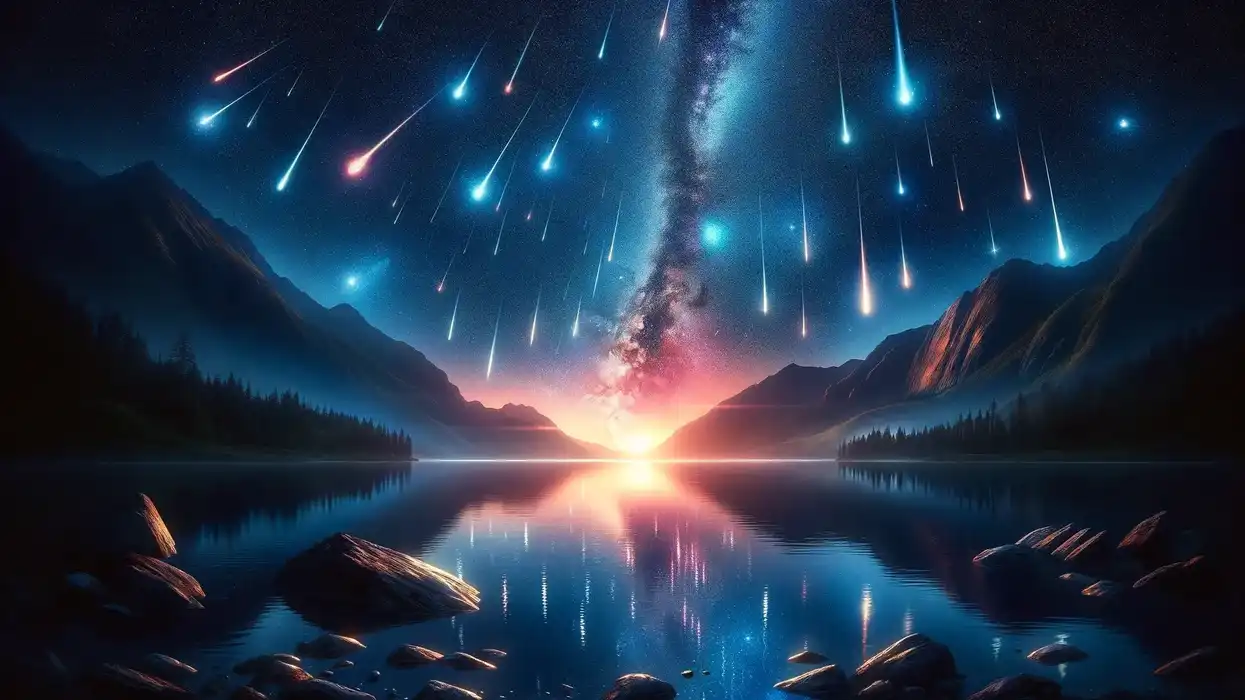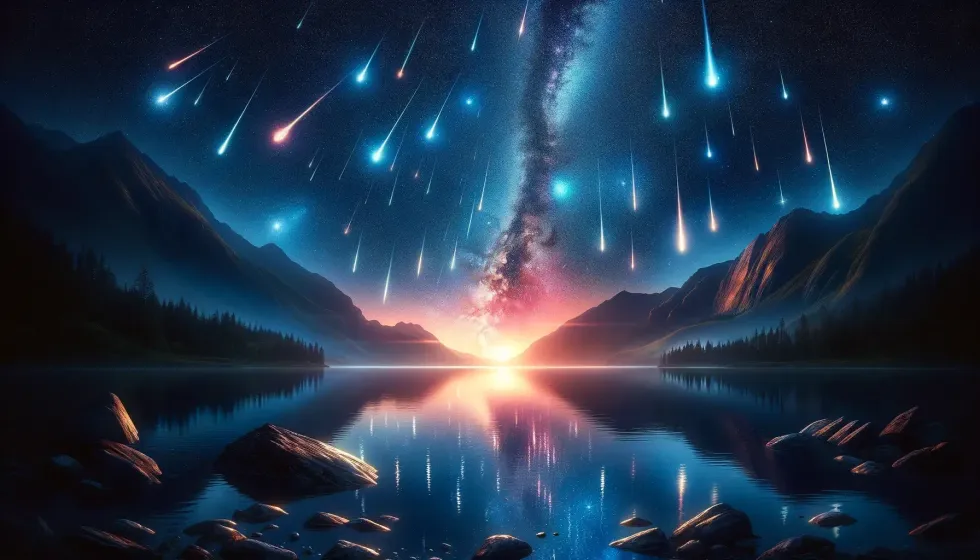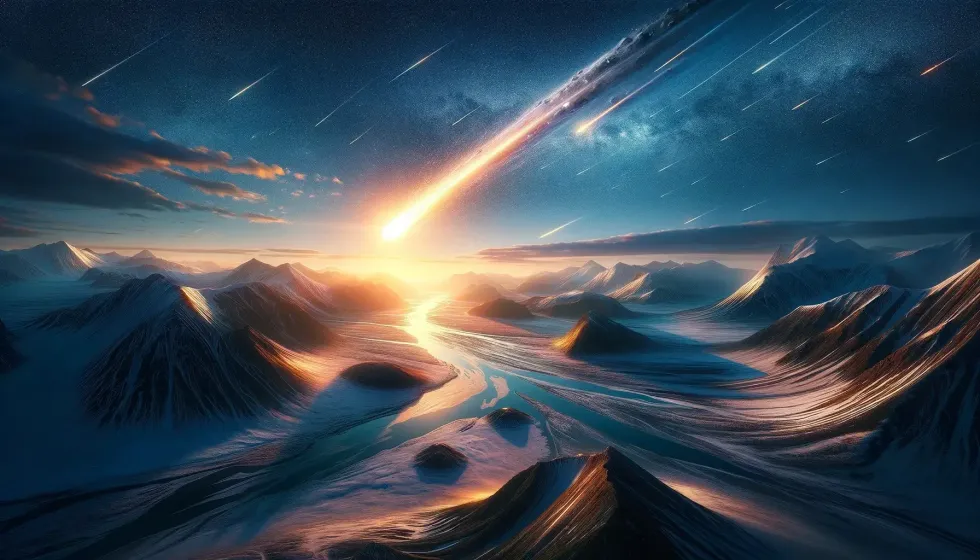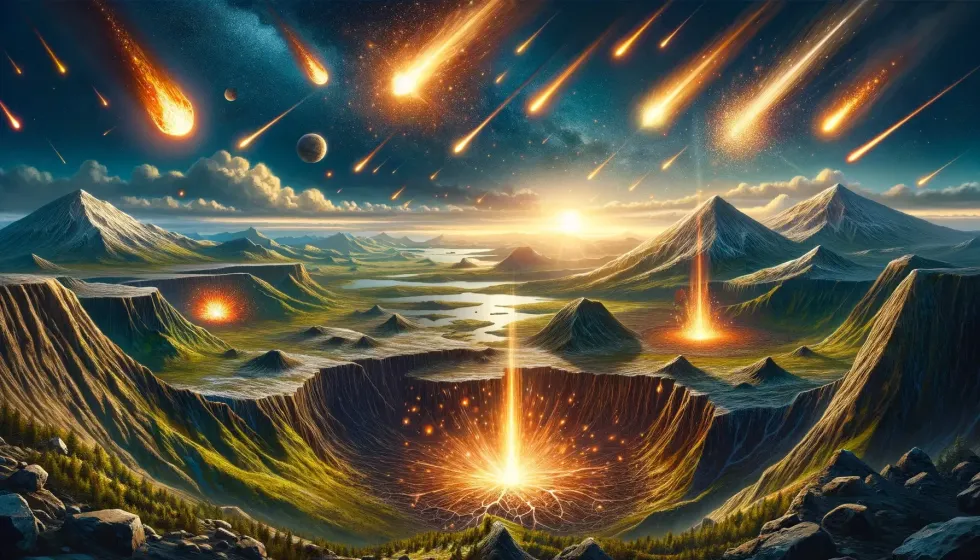Meteor phenomena have captivated humans for thousands of years. The awe-inspiring trails of light streaking across the night sky and the impact craters left on Earth's surface tell the story of the origins and inner workings of the solar system.
Whether it's a lone meteor flashing across the sky or an annual meteor shower gracing the heavens, every meteor has a story that intertwines with Earth's history. This exploration delves into the truths behind these celestial bodies that dance through Earth's atmosphere, often leaving a striking impression in the sky or, when they reach the ground, upon Earth's surface.
Interesting Meteor Facts: Understanding Meteors And Meteor Showers

Prepare to discover the reasons behind the appearance of numerous shooting stars lighting up the sky together! Learn about the natural events that cause these spectacular star showers and their fascinating visual display.
- Meteors, commonly known as shooting stars, are solid particles from outer space entering Earth's atmosphere at high speeds.
- These space rocks, often no larger than a small asteroid, can create bright streaks in the sky as they burn up due to friction with air particles.
- When Earth passes through the trail of space dust left by comets, such as Leonids with Comet Tempel-Tuttle, meteor showers occur, treating viewers to several meteors per hour in the night sky.
Facts About Meteors, Meteoroids, And Meteorites
Are you ready to unravel the secrets of space rocks? Learn the difference between a shooting star, a space rock flying through space, and the bits that crash-land on Earth.
- Meteors are the visible streaks of light or 'shooting stars' resulting from meteoroids entering the atmosphere.
- Meteoroids are space debris from comets or asteroids that become meteors once they encounter a planet's atmosphere.
- Meteorites are the remnants of meteoroids that land on a planet's surface without completely burning up.
Meteor Classification And Famous Meteorites

Did you know different kinds of space rocks land on Earth? Some are like the rocks you see on the ground, and others have metal in them. There's even a really big space rock that made a massive hole in the ground in Arizona!
- Stony meteorites, primarily composed of silicate minerals, are among the most common meteorites on Earth.
- Iron meteorites, also known as siderites, are primarily composed of iron and nickel and are denser and less common than stony types.
- Carbonaceous chondrites are known for their rich organic compounds and water content, hinting at early solar system chemistry.
- Notable meteorites include the Allende meteorite, known for its composition, and the Chelyabinsk meteor, remembered for its powerful shock wave.
Key Meteor Facts You Should Know

What fascinating secrets do shooting stars hold? Discover how fast they zoom across the sky, how big they can be, and what they're made of when they light up the night.
- Meteors are visible results of space material interacting with Earth's atmosphere, sometimes landing as meteorites.
- Ann Hodges of Sylacauga, Alabama, was famously struck by a stony meteorite in 1954, marking the first recorded instance of a human hit by a meteorite.
- Iron meteorites consist primarily of iron and nickel and typically originate from asteroid cores; a notable example is the 'Lebanon' meteorite found on Mars by NASA's Curiosity rover.
- A meteor's life cycle begins with a space dust particle, which turns into a 'shooting star' when it enters Earth's atmosphere and heats up.
- During entry, heat from friction can lead to the formation of molten droplets of meteoritic material.
- Most meteorites disintegrate into dust and do not reach Earth's surface intact due to atmospheric heat.
- Larger meteoroids may create substantial impact formations or survive to become meteorites, whereas smaller ones often burn up entirely.
- Meteor showers, such as the Perseids, occur when Earth traverses a comet's debris path. They showcase many meteors at once and fascinate onlookers.
- Meteoroid impacts are common cosmic events affecting Earth and other planetary surfaces across the solar system.
- Meteors and meteorites provide a tangible connection to space, emphasizing Earth's place in the cosmos.
- Meteor storms, which are rare, can produce hundreds or thousands of meteors per hour, often due to dense debris trails from comets.
- The Chelyabinsk event is an example of an intense meteor causing an airburst, which released significant energy.
- The asteroid belt, nestled between Mars and Jupiter, resides in the inner solar system, while the outer solar system houses the Kuiper Belt and the hypothetical Oort Cloud. Home to icy objects and dwarf planets like Pluto, the Kuiper Belt produces short-period comets. The Oort Cloud, believed to envelop the solar system, is thought to give rise to long-period comets.
- Meteorite impacts occur on planets like Mars, similar to Earth, influencing their geological history.
- Earth's moon's surface has numerous craters due to meteoroid impacts over time.
- Meteor craters are formed by the high-energy impact of meteoroids, such as the Chicxulub crater linked to the Cretaceous–Paleogene (K–Pg) mass extinction event of approximately 80% of plant and animal species on Earth, including all non-avian dinosaurs.
- Barringer Meteor Crater in Arizona is a well-preserved crater that offers insight into the impact power of meteorites.
- Impacts of meteoroids can generate shock waves and release energy comparable to explosions upon striking a planet.
Bit-Sized Facts On The Cultural And Scientific Significance Of Meteors
Find out how shooting stars have amazed people for thousands of years. They spark fun stories and help scientists learn new things about space!
- The Northern Hemisphere is often a prime location for observing meteor showers like the Perseids.
- Collected meteoritic material is analyzed by scientists for insights into the compositions and ages of various solar system bodies.
- The Hoba meteorite is the largest known meteorite on Earth and provides important information due to its size and preservation.
FAQs
What causes a meteor shower?
A meteor shower occurs when Earth passes through the stream of debris left by a comet, which is comprised of ice, dust, and rock particles.
When these particles, often no larger than a grain of sand, enter Earth's atmosphere, they burn up due to the intense heat generated by friction, creating the streaks of light known as meteors or shooting stars.
During a meteor shower, many meteors can be seen entering the atmosphere in a relatively short period. They appear to emanate from a single point in the sky known as the radiant, which corresponds to the constellation where the comet's path lies. The consistency of comet debris trails means meteor showers are largely predictable and occur annually.
How do you differentiate between a meteoroid, a meteor, and a meteorite?
Though commonly confused, these three terms refer to different stages of a space rock's journey. A meteoroid is a small particle from the asteroid belt or a fragment from a comet that travels through space. When a meteoroid enters Earth's atmosphere and ignites due to friction, it creates a visible streak of light called a meteor.
If the meteoroid is large enough to survive its fiery journey through the atmosphere and reaches the Earth's surface, it becomes a meteorite.
What is the difference between a meteor and a shooting star?
The terms 'meteor' and 'shooting star' are often used interchangeably, but there's no real difference between the two. A shooting star is the layman's term for the light phenomenon observed when a meteoroid enters the Earth's atmosphere and vaporizes due to heat from the intense air friction.
Although meteors are not stars, the fast streak they create in the sky can give the illusion of a star's movement, thus the name. Most meteors are particles from comets or asteroids that completely burn up before reaching the planet's surface. Only rarely do they survive the journey to become meteorites.
Can a meteor impact cause significant damage to the Earth?
While most meteors are too small to reach the Earth's surface, larger meteoroids can create significant impact events when they collide with Earth. These collisions can result in craters and have been known to cause substantial environmental changes. For example, the Chicxulub impact is widely believed to have resulted in the mass extinction of the dinosaurs.
Earth's atmosphere mostly acts as a protective shield, causing smaller meteoroids to disintegrate. However, larger meteoroids, like the one that exploded over Chelyabinsk, Russia, in 2013, can cause damage through powerful shock waves, even if they don't directly strike the surface.
What is a meteor storm, and how is it different from a meteor shower?
A meteor storm is a rare event that occurs when Earth passes through an unusually dense cloud of comet debris, resulting in an extraordinary number of meteors entering the atmosphere per hour. Meteor storms can feature thousands of meteors per hour, significantly more than the average meteor shower, which typically has tens to hundreds of meteors per hour.
Meteor storms provide a spectacular show and are much more intense than the typical meteor shower. They are rare and unpredictable, as they depend on the comet's nucleus's unpredictable disintegration rate and debris density.
Are meteorites hot when they reach the Earth?
Contrary to popular belief, meteorites do not scorch when they land. Although their entry into Earth's atmosphere generates enormous heat, causing the meteorite's surface to melt and form a fusion crust, the interior does not heat up significantly.
When meteorites pass through the atmosphere and reach the ground, the outer layer has cooled. Some meteorites are even reported to feel cold to the touch due to the outer layers cooling rapidly during the final stages of descent.
How large is the largest meteorite found on Earth?
The title of the largest meteorite found on Earth goes to the Hoba meteorite in Namibia, which remains where it fell. The meteorite is estimated to weigh around 66 tons (5,9874 kg) and is roughly 9 ft (2.7 m) long by 9 ft (2.7 m) wide.
Despite its size, it was discovered only in 1920, as due to its flat shape and slow descent, it didn't create a crater upon impact.
Researchers believe Earth's atmosphere significantly slowed the Hoba meteorite's speed, resulting in a soft landing. This iron-nickel meteorite is now a popular tourist attraction and continues to be studied by scientists worldwide.
What can meteorites tell about space?
Meteorites are cosmic time capsules that provide clues about the formation and composition of our solar system. They often contain materials that have not been altered for billions of years. Studies of meteorites can reveal details about the conditions in the early solar system, including evidence of water and organic compounds on asteroids.
Scientists estimate that some meteorites contain presolar grains, particles older than the solar system, offering insights into the broader cosmos. By studying different classes of meteorites, such as chondrites and achondrites, researchers better understand planetary formation, including the geologic history of Mars and the Moon.
Are meteor showers visible from everywhere on Earth?
Visibility of meteor showers depends on several factors, including the time of year, the shower's radiant point, and the observer's location. Some meteor showers are best viewed from the Northern Hemisphere, while others are more visible from the Southern Hemisphere.
Local weather conditions, light pollution, and the moon's phase can also affect the visibility of meteor showers. For the best viewing experience, observers should find a dark, clear sky away from city lights. Most meteor showers occur annually, and there are many resources online to predict the best times for observing these celestial events in specific locations.
How often do meteor showers occur?
Meteor showers typically occur when Earth passes through the trail of debris left by a comet, which can happen annually at predictable intervals. The Perseids, one of the most famous meteor showers, occur annually around August and are caused by the debris from Comet Swift-Tuttle.
Some meteor showers happen at different times each year, depending on the orbit of the associated comet. Observers can enjoy over a dozen significant meteor showers annually, with varying intensities and numbers of visible meteors. Remember, observing a meteor shower can be a memorable experience, with some offering up to 100 meteors per hour during their peak activity.
How fast is a meteor?
Meteors are known for their swift journey through Earth's atmosphere. The speed at which a meteor travels can vary widely, typically ranging from about 25,000-160,000 mph (40,000-257,495 kph) as it vaporizes or explodes during entry.
The velocity depends on several factors, including the meteoroid's original speed in space and its angle of entry into the atmosphere. The rapid interaction with air molecules causes the meteoroid to heat up and emit light, creating the bright trail commonly associated with these shooting stars.
One reason meteors can often be hard to spot is their intense speed. They blaze across the night sky in a fraction of a second. Occasionally, slower-moving meteors, known as fireballs, can be seen for several seconds, illuminating the sky with their brilliant trails. The enduring allure of these fleeting cosmic phenomena continues to captivate skywatchers and scientists alike.
Meteors and their resultant meteorites present a fascinating glimpse into the cosmic processes that shape the solar system. From the annual light displays of meteor showers to the scientific revelations from meteorite analysis, these celestial phenomena connect one to the distant reaches of space and time.
The enduring impacts on Earth and others within the solar system underscore the dynamic nature of celestial mechanics. Through continued observation and study, each discovery propels one's understanding of the universe forward, unveiling the grand narrative of the cosmos.
Related Articles Around the Web












